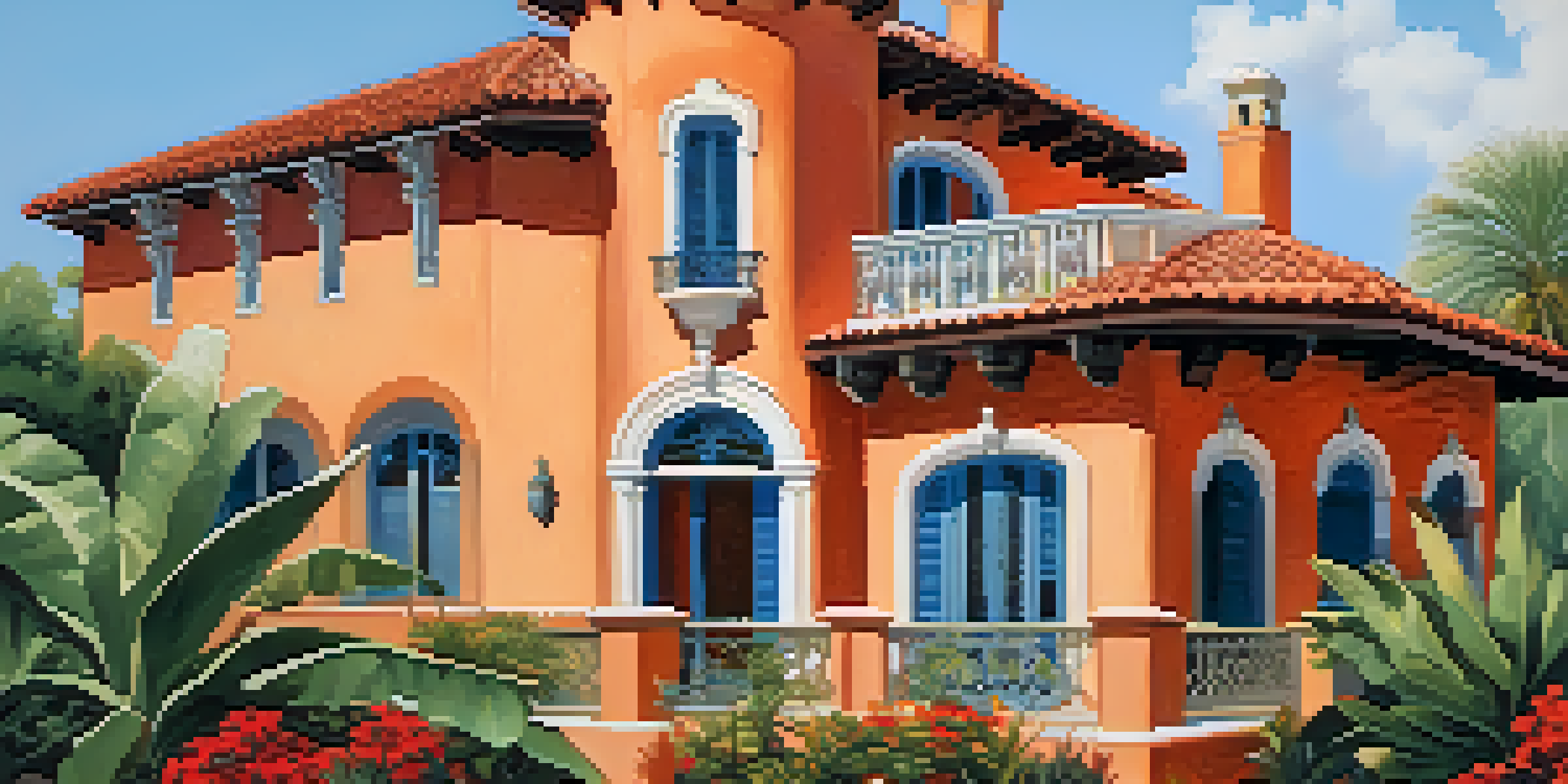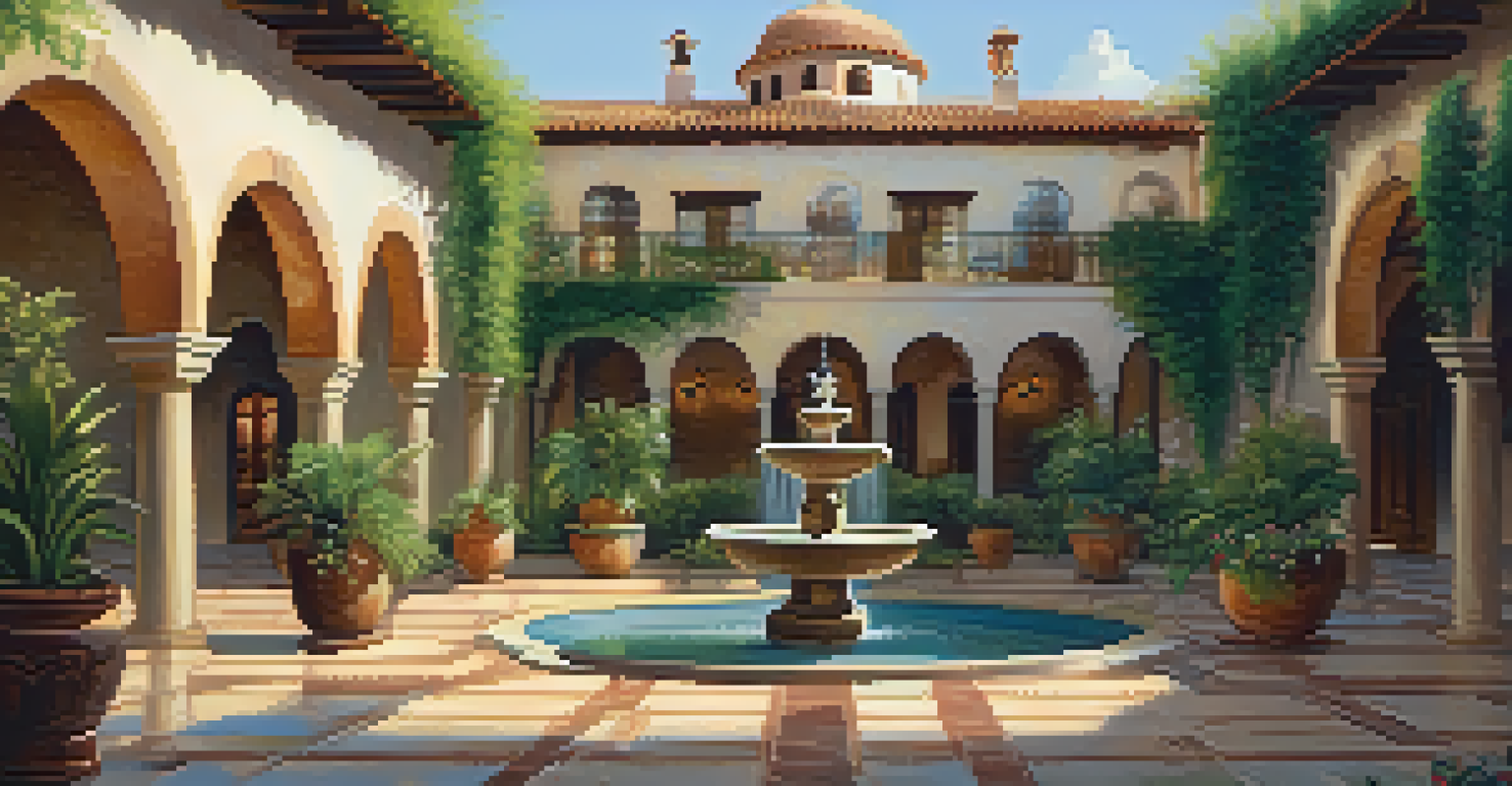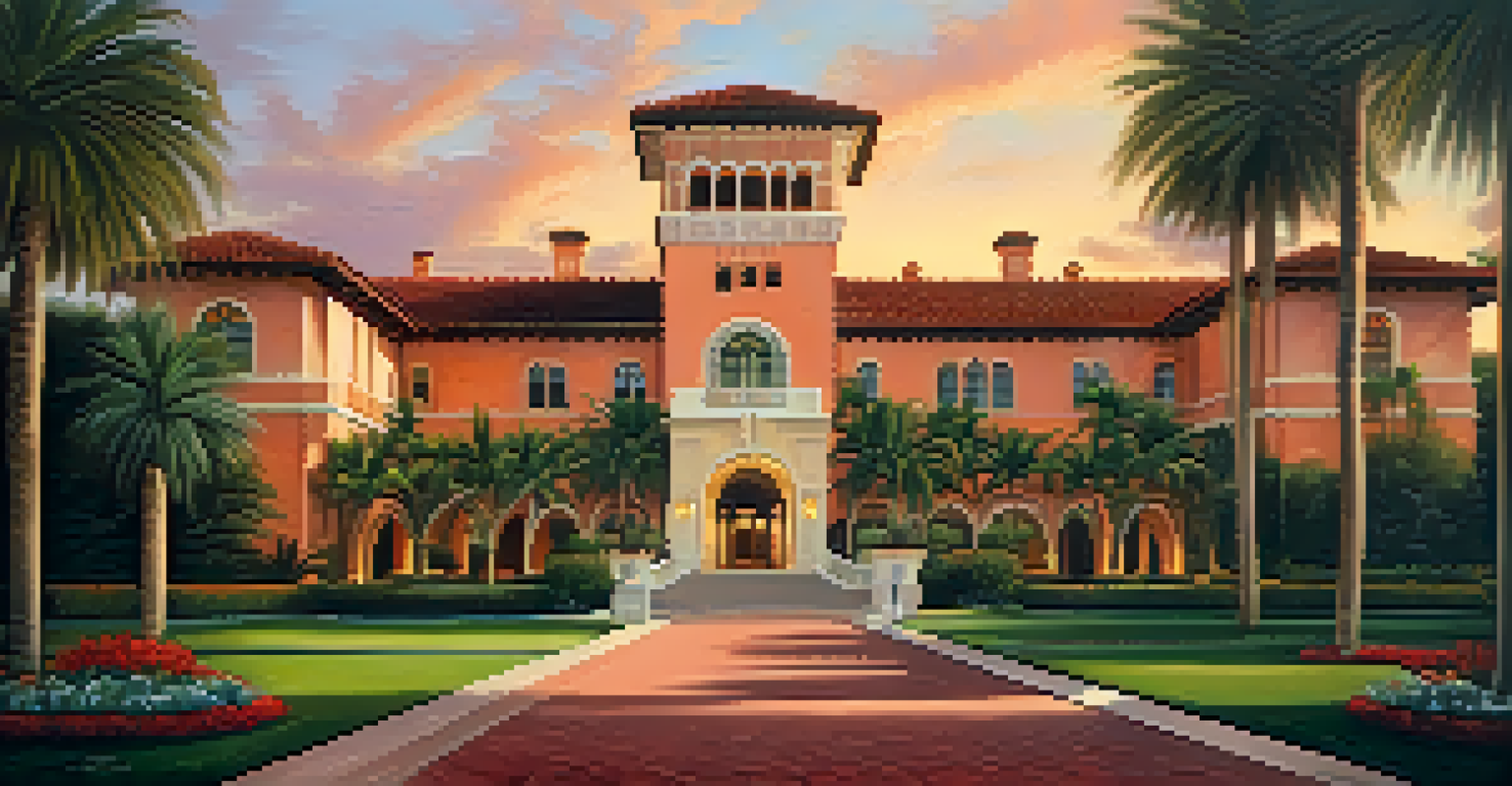Exploring Florida's Spanish Colonial Revival Architectural Style

Introduction to Spanish Colonial Revival Architecture
Florida's architectural landscape is a vibrant tapestry, and the Spanish Colonial Revival style stands out as a hallmark of elegance. This style, which emerged in the early 20th century, draws inspiration from the rich heritage of Spanish colonial structures. It’s characterized by its stucco exteriors, red-tiled roofs, and intricate wrought-iron details, creating a nostalgic yet timeless appeal.
Architecture is the learned game, correct and magnificent, of forms assembled in the light.
Often seen in cities like St. Augustine, Miami, and Tampa, Spanish Colonial Revival architecture reflects Florida's historical ties to Spain. The revival was part of a broader movement in the United States that sought to celebrate and preserve regional architectural styles. This fusion of history and design has turned many buildings into landmarks that tell the story of Florida's past.
As we dive deeper into this architectural style, we’ll explore its key features, historical significance, and famous examples. Each section will reveal how this style has shaped Florida’s identity and continues to influence modern architecture in the state.
Key Features of Spanish Colonial Revival Style
Spanish Colonial Revival architecture is celebrated for its distinctive features that evoke a sense of warmth and charm. Key elements include stucco walls, arched doorways, and elaborate tile work, which all contribute to a cozy yet sophisticated atmosphere. The use of wrought iron — seen in gates, balconies, and light fixtures — adds an artistic touch that enhances the style's character.

Another hallmark of this architectural style is its integration with the surrounding landscape. Buildings often feature lush courtyards and gardens that reflect the natural beauty of Florida. The design encourages outdoor living, making it perfect for the state's warm climate, where residents can enjoy the sun and fresh air.
Key Features of Spanish Colonial Revival
This architectural style is characterized by stucco walls, red-tiled roofs, and intricate wrought-iron details that evoke warmth and charm.
Additionally, the color palette is typically warm, featuring earthy tones like terracotta, beige, and soft pastels. This harmonious blend of colors and materials creates an inviting environment and helps buildings to blend seamlessly into their surroundings.
Historical Context of the Revival Movement
The Spanish Colonial Revival movement began in the early 20th century, coinciding with a growing interest in regionalism across the United States. Architects sought to fuse their designs with local history, and Florida's unique Spanish heritage presented a perfect opportunity to do so. This movement not only celebrated the past but also responded to the needs of a rapidly growing population.
The mother art is architecture. Without an architecture of our own, we have no soul of our own civilization.
In Florida, the revival was influenced by the state's rich colonial history, particularly in areas like St. Augustine, which is the oldest continuously inhabited European-established settlement in the continental United States. The 1915 Panama-California Exposition in San Diego further popularized the style, showcasing its beauty to a broader audience and inspiring architects back East.
As the state developed, cities like Miami and Tampa embraced the Spanish Colonial Revival style, incorporating it into civic buildings, homes, and commercial structures. This architectural choice symbolized a connection to the past while projecting a sense of sophistication and cultural richness.
Famous Examples of Spanish Colonial Revival in Florida
Florida is home to several iconic examples of Spanish Colonial Revival architecture, each with its own unique story. One of the most famous is the Flagler College in St. Augustine, originally the Ponce de Leon Hotel, which showcases stunning mosaics, turrets, and an impressive courtyard. The building's intricate design captures the elegance of the era and serves as a reminder of the region's historical significance.
Another notable example is the Biltmore Hotel in Coral Gables, a luxurious establishment that boasts a blend of Moorish and Spanish influences. With its grand arches, beautiful gardens, and opulent interiors, the Biltmore remains a beloved landmark and a testament to the style's enduring appeal. It has even hosted numerous celebrities and dignitaries over the years, further cementing its status in Florida’s architectural history.
Cultural Significance of the Style
Spanish Colonial Revival architecture reflects Florida's diverse heritage and fosters community pride and belonging.
Lastly, the Venetian Pool in Coral Gables is a picturesque public swimming pool that originated from a limestone quarry. Its design features Spanish tile work, waterfalls, and lush landscaping, making it a perfect example of how the Spanish Colonial Revival style can harmonize with natural elements. These landmarks not only showcase the beauty of the architecture but also serve as cultural hubs for the community.
Influence on Modern Architecture in Florida
The influence of Spanish Colonial Revival architecture is still evident in modern Florida homes and commercial buildings. Many architects today draw inspiration from this style, incorporating its key elements into contemporary designs. This blend of old and new allows for a unique aesthetic that pays homage to history while meeting the needs of modern living.
For instance, new residential developments often feature stucco exteriors and tile roofs, reminiscent of the classic Spanish Colonial Revival homes. This approach not only preserves the architectural heritage of Florida but also appeals to buyers looking for a distinctive, charming home. Developers are also mindful of the surrounding environment, ensuring that new constructions complement the natural beauty of the landscape.
Additionally, the resurgence of interest in sustainable building practices has led to a revival of traditional techniques found in Spanish Colonial architecture. Features like passive cooling through thick walls and shaded verandas are becoming popular again, showcasing how this historical style can adapt to contemporary needs while promoting energy efficiency.
Cultural Significance of Spanish Colonial Revival
The Spanish Colonial Revival style is more than just an architectural choice; it represents a rich cultural narrative that intertwines with Florida's identity. This style reflects the state's diverse heritage, including influences from Spanish, Mexican, and indigenous cultures. By preserving these architectural treasures, we honor the stories and traditions that have shaped Florida.
Moreover, the style fosters a sense of community and belonging. Many neighborhoods characterized by Spanish Colonial Revival homes have become tight-knit communities where residents take pride in their unique architectural heritage. This shared appreciation for the style often leads to community events, historical tours, and preservation initiatives that strengthen local ties.
Preservation Efforts for Historical Sites
While facing challenges from urban development and neglect, local communities are actively advocating for the protection of these architectural treasures.
In this way, Spanish Colonial Revival architecture serves as a bridge connecting past and present, reminding us of the importance of cultural heritage in shaping our identities. As Floridians continue to celebrate this architectural style, they also reinforce the values of inclusivity and respect for the diverse histories that contribute to the state's character.
Preservation Efforts and Challenges
As with any historical architecture, preservation efforts for Spanish Colonial Revival buildings can be both rewarding and challenging. Many of these structures face threats from urban development, neglect, and the natural elements. However, grassroots organizations and local governments are stepping up to advocate for the protection and restoration of these architectural gems.
Community involvement plays a crucial role in preservation efforts. Local residents often rally together to form historical societies that aim to protect their neighborhoods' unique character. These groups work tirelessly to raise awareness and funds for restoration projects, ensuring that future generations can appreciate the beauty of Spanish Colonial Revival architecture.

Despite these efforts, challenges remain. Balancing modern development with the preservation of historical sites can be a contentious issue. However, with continued advocacy and a shared commitment to honoring Florida's architectural heritage, there's hope that these stunning structures will be preserved for years to come.